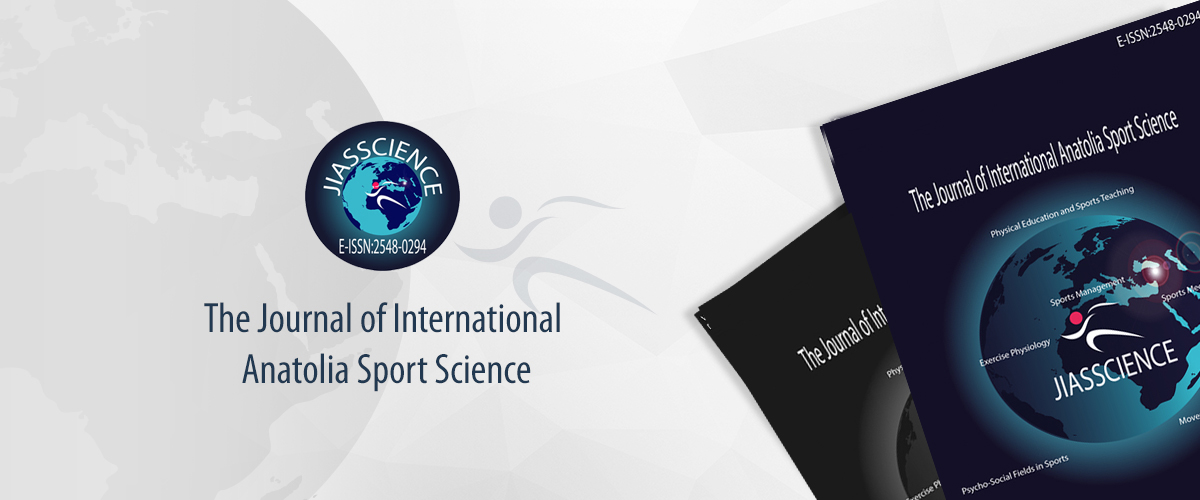E-ISSN: 2548-0294

Cilt: 6 Sayı: 1 - 2021
| ORIJINAL ARAŞTIRMA | |
| 1. | Physical Activity and Wellness Halit Egesoy, Hayrettin Gümüşdağ, Fatma Ünver, Eylem Çelikdoi: 10.5505/jiasscience.2021.30075 Sayfalar 1 - 8 Living conditions, technology and conveniences brought about by modernization, are making people less active on a daily basis. These changes, affect the health status of the people as the level of physical activity gradually decreases and consequently different health problems may occur. Regular exercise is the most effective method of protection from diseases. There is evidence in the literature about physical activity, cardiospiratory status, muscle strength, metabolic health and bone health. There is strong evidence that mortalities, coronary heart disease, high blood pressure, paralysis, diabetes, metabolic syndrome, colon and breast cancer and depression are less common in more active individuals than in less active men and women. There is also strong evidence supporting a better cardiorespiratory and better level of muscular fitness in active individuals, a healthier and better body composition, effective cardiovascular disease and prevention of type II diabetes, and better bone health. It is also stated that regular physical activity with lifestyle modification plays an important role in preventing weight loss and reintroduction of given weight in obese individuals. Studies have shown that regular physical activity decreases the level of low-density lipoprotein (LDL), while that of high-density lipoprotein (HDL) increases. As a result, studies in the literature report a linear relationship between physical activity and health status and draw attention to the protective effect of exercise in the prevention of diseases. It is possible to obtain health benefits by appropriately adapting physical activities to age. |
| 2. | An Investigation of the Faculty of Sports Sciences Students' Problem-Solving Skills in Terms of Some Variables Veysel Temel, Kazım Nasdoi: 10.5505/jiasscience.2021.35119 Sayfalar 9 - 19 The study aims to determine whether the problem-solving skill levels of students studying at the faculty of sports sciences differ according to some variables. The model of the research is descriptive, one of the quantitative research methods. The research group consists of 185 students (Mean age = 21.42 ± 2.45) studying at the faculty of sports sciences. The "Problem Solving Inventory" and "Personal Information Form" developed by the researcher to determine the personal characteristics of the students were used as data collection tools. Seven types of problem-solving scores are obtained with the scale, including the total problem solving and its sub-dimensions: impetuous approach, considering approach, avoidant approach, evaluative approach, self-confident approach and planned approach. As a result of the Skewness-Kurtosis technique performed to determine whether the measurements were suitable for normal distribution, it was understood that all dimensions showed normal distribution. X̄, S and t-Test, One-Way ANOVA analysis of variance and Bonferroni test were used to determine the source of the difference. It was determined that the students participating in the study have above the middle level of the problem-solving skills and its sub dimensions, but they have below the mid-level of the impetuous approach from the problem-solving sub-dimensions. It was concluded that there was a statistically significant difference in terms of gender, age and class variables of the participants according to their personal characteristics, while there was no statistically significant difference in terms of the duration of doing sports and having difficulty in evaluating their leisure time. |
| 3. | Determination Of The Correlation Between Sports Managers Strategic Leadership Characteristics And Employees Job Satisfaction Kaan Karakuş, Burkay Cevahircioğlu, Erdal Arıdoi: 10.5505/jiasscience.2021.87597 Sayfalar 20 - 32 The aim of this descriptive study was to determine the correlation between strategic leadership characteristics of sports managers and job satisfaction of employees in Ordu Provincial Directorate of Youth and Sports. This study was correlational screening model with descriptive feature. The sample consisted of 290 employees from Ordu Provincial Directorate of Youth and Sports. The data was collected by the Strategic leadership Scale and Job Satisfaction Scale. The normality of data distribution was examined by Kolmogorov-Smirnov test. The independent samples T-test and one-way analysis of variance (one way ANOVA) for parametric data and Mann Whitney-U and Kruskal Wallis-H tests for nonparametric data were used. In pairwise comparisons between groups, the Tukey test for parametric data and Mann Whitney-U test with Bonferroni correction were used. The Spearman correlation analysis was used for examination of relationship between strategic leadership features and job satisfaction of employees. Data were analyzed using The Statistical Package for Social Sciences (SPSS 25.0) was used in all statistical analysis. The statistical significance level was accepted as p<0.05 in all statistical analysis. According to analysis results, the strategic leadership features of managers and job satisfaction of employees were significantly differentiated according to gender, age, income level, education level, work period at institution, work period with manager. It was determined that the strategic leadership features of managers and job satisfaction of employees were not significantly differentiated according to marital status and children number. According to results of correlation analysis, it was determined a positive and significant correlation between the strategic leadership features of managers and job satisfaction of employees. Consequently, the job satisfaction of employees is closely related to strategic leadership features of managers and the job satisfaction and productivity of employees may be increased by effective usage of strategic leadership features. |








